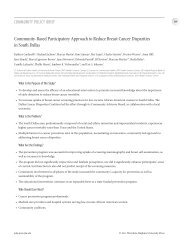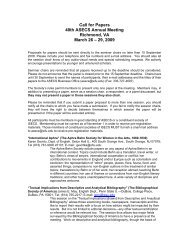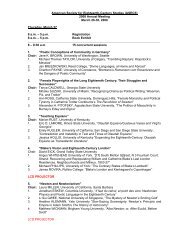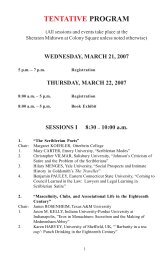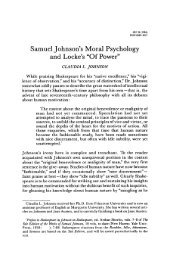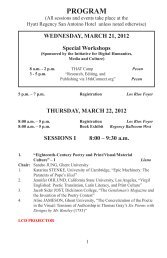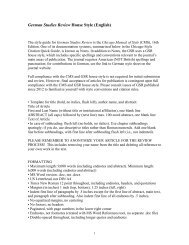Fall 2008 - The Johns Hopkins University Press
Fall 2008 - The Johns Hopkins University Press
Fall 2008 - The Johns Hopkins University Press
Create successful ePaper yourself
Turn your PDF publications into a flip-book with our unique Google optimized e-Paper software.
New in PaperbackConceiving Risk,Bearing ResponsibilityFetal Alcohol Syndrome and the Diagnosis of Moral DisorderElizabeth M. ArmstrongFinalist, C. Wright Mills Award, Society for the Studyof Social ProblemsDrinking during pregnancyhas come to be considereda pervasive social problem,despite the uncertainties surroundingthe epidemiologyand etiology of fetal alcoholsyndrome (FAS).Sociologist Elizabeth M.Armstrong traces the evolutionof medical knowledgeabout the effects of alcoholon fetal development fromnineteenth-century debatesabout drinking and heredityto the modern diagnosis of FAS and its kindred syndromes.Medical beliefs about drinking during pregnancy have oftenignored the poverty, chaos, and insufficiency of somewomen’s lives—factors that may be more responsible thanalcohol for adverse outcomes in babies and children.“Armstrong draws attention to some important questions about ourperceptions of responsibility for alcohol-related harm sustained duringpregnancy . . . I hope that her book will lead to a healthy debateand a more objective ethical, medical, and scientific approach to thisfield in the future.”—Addiction“<strong>The</strong>re is much to admire in Armstrong’s account: her clever deconstructionof the advocates’ invented history of FAS, her sure-handeddiscussion of the politics of reproduction, and her often fascinatinginterview material.” —Perspectives in Biology and Medicine“In this well-written book, Armstrong provides an in-depth analysis offetal alcohol syndrome as a social problem.”—American Journal of SociologyElizabeth M. Armstrong is an associate professor of sociologyand public affairs at Princeton <strong>University</strong>.Prescribing by NumbersDrugs and the Definition of DiseaseJeremy A. Greene<strong>The</strong> second half of the twentiethcentury witnessed theemergence of a new model ofchronic disease—diagnosedon the basis of numerical deviationsrather than symptomsand treated on a preventivebasis before any overt signs ofillness develop—that arose inconcert with a set of safe, effective,and highly marketableprescription drugs. PhysicianhistorianJeremy A. Greeneexamines the mechanisms bywhich drugs and chronic disease categories define one anotherwithin medical research, clinical practice, and pharmaceuticalmarketing, and he explores how this interactionhas profoundly altered the experience, politics, ethics, andeconomy of health in late-twentieth-century America.“Greene describes the relationship between advances in treatment, theincentives of manufacturers, and the effect on the public of increasedattention to prevention . . . <strong>The</strong> risk-benefit trade-offs of the quantitativeapproach are complex, and Greene’s historical revelations aretimely.”—New England Journal of Medicine“One of the best, and most significant, books published recently onthe development of medical practice and the pharmaceutical industryin the U.S. in the second half of the twentieth century.”—Social History of Medicine“A nuanced description of the development of ‘therapeutics of riskreduction’ with multiple lines of influence, subtle power shifts, andgains and losses for patients and physicians.”—Chemical HeritageJeremy A. Greene is a fellow in the Department of SocialMedicine at Harvard Medical School and a resident inthe Department of Medicine at Brigham and Women’sHospital.September 304 pages 6 x 9 12 illustrations978-0-8018-9108-3 0-8018-9108-6 $25.00(s) / £14.00 pbHistory of MedicineDecember 336 pages 6 x 9 10 halftones, 3 line drawings978-0-8018-9100-7 0-8018-9100-0 $25.00(s) / £14.00 pbHistory of MedicineHardcover edition published in 2003, 978-0-8018-7345-4, 0-8018-7345-2 Hardcover edition published in 2006, 978-0-8018-8477-1, 0-8018-8477-2THE JOHNS HOPKINS UNIVERSITY PRESS www.press.jhu.edu 66



